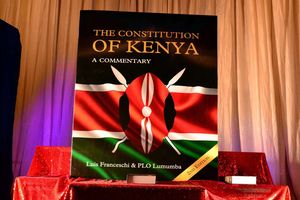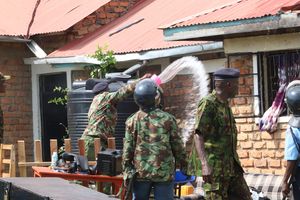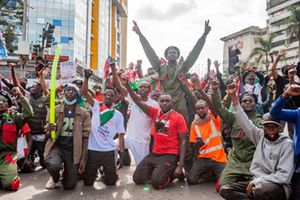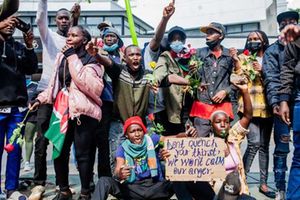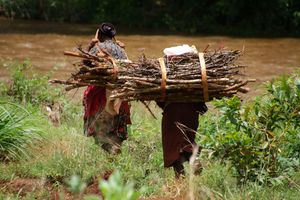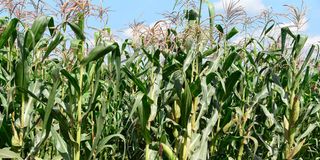
A maize farm.
"If food is the staff of life,/ Should there be famine, war and strife?/ For like the ant should man proceed,/ To fulfil his want and needs.
And that is food./ And without it you are in a devastating mood,/ Oh yes that is food.
You better treat it like you know you should,/ And that is food.
And without it you are in malnutritious mood,/ ..If bread is for man for to eat,
Why should he die for lack of meat?
For in the multitude of wine and laughter,/ He's suffering from hunger." — (Food by Neville Oril Livingston)
The period is the late 18th century in France. The people are rioting because of widespread famine and other reasons. France is being ruled by a monarch, King Louis XVI. His wife is Queen Marie Antoinette.
The queen is so removed from the ordinary lives of the people that when she hears they are rioting because of lack of bread, she reportedly suggests "let them eat cake instead". It is a famous quote that has various versions but historians doubt if she ever uttered those words.
Nonetheless, this was a case of the queen being so unpopular due to her lavish lifestyle during those heady days leading to all manner of propaganda that stuck.
But Queen Marie Antoinette’s detachment "from the ground" is a common phenomenon in leadership and societies: elites of whatever shade versus the common person. These are parallel worlds of people who live side by side.
The best marker of this divide is manifested in policies. Detached elites, for instance, have a tendency to downplay the agricultural sector. They generally live in swanky urban areas. But the common person’s true reality is centred around agriculture and rural living.
Food production
At the core of agriculture is food production by small-scale farmers, and within the Kenya setup, it has to be maize farming. This is because maize is Kenya's staple food.
But various policies ignore the centrality of maize towards the food security of Kenya. For example, Kenya has an agricultural sector partnership with the World Bank known as the National Agricultural Value Chain Development Project (NAVCDP).
It is implemented by the Ministry of Agriculture and Livestock Development with counties acting as the implementing agencies. The key aim is to help transit small-scale farmers from subsistence to commercial farming in select counties.
The aims are good but the project has certain flaws. First, the design is top-down with instructions flowing from the World Bank to the ministry then to counties. Attempts by countries to align the programme with their developmental goals have been rebuffed both by the Ministry and World Bank. Second, the substantive structuring of the programme requires improvement. For example, omitting maize as a value chain requiring support is a fatal flaw.
Maize farming as a food security initiative can be improved in several ways in Kenya, particularly among small-scale farmers.
First is the provision to farmers of certified seeds. Kenya has a rampant problem of fake seeds. In instances where the seeds are genuine, their cost tends to be prohibitive. One 2kg bag of seeds is about Sh1,000 — an amount out of reach for many poor farmers. Therefore, good policies should help farmers access certified seeds.
Second, provide farmers with planting and top-dressing fertiliser. Africa has the lowest rate of fertiliser application worldwide contributing to lower yields. The current subsidised price of Sh2,500 per 90kg bag remain expensive to a majority of poor farmers.
For example, the National Cereals and Produce Board sold about 20,000 bags of planting fertiliser in Murang’a County for the year 2024. That translates to 20,000 individual farmers assuming each bought a single bag.
Buy fertiliser
But the Murang’a County Government supplied fertiliser that was divided among 60,000 who shared smaller portions. Those with the ability to buy fertiliser from the National Cereals and Produce Board (NCPB) represented 20 per cent of total farmers.
Being an expensive endeavour, counties would appreciate support from NAVCDP towards fertiliser purchases.
Third, provide pesticides to fight the fall armyworm. This worm causes an average 45 per cent loss of maize output.
Fourth, provide commercial driers for maize. Commercial maize should have a moisture content of 13.5 per cent at the time of harvest. Often this demands investment in driers since sun drying can cause delays in harvesting.
Finally, create market linkages with maize millers. Kenya has a fairly developed maize milling industry, which buys large quantities of maize outside the country, unfortunately.
Murang’a County Government entered into uptake agreements with maize millers which helped establish a minimum farmers price of Sh3,500 for 90kg bag up from Sh2,300.
The counties are, therefore, compelled to tap on their own resources to fund such as opposed to tapping at these available funding.
Unfortunately, NAVCDP work plans are tilted towards training that helps Government officials both at the National and County levels as opposed to expending resources towards the common farmer.
The NAVCDP secretariat argues that counties develop those work plans. But the reality it is the opposite. A select team of county officials are invited to meetings in top hotels and commit counties to work plans that do not mirror the reality on the ground.
By the way, these World Bank programmes often are loans to be repaid by the taxpayer, not grants. The World Bank should rethink this programme and craft it in a manner that mirrors the true reality of Kenyan rural farmers. Maize farming should be central to the programme. A detached mindset can only foster a Marie Antoinette detachment.
Dr Kangata is the Governor of Murang’a County; [email protected]

